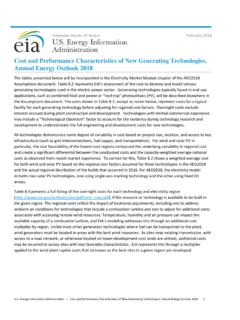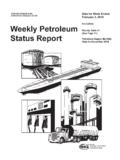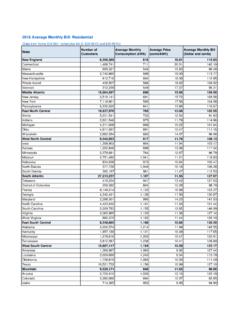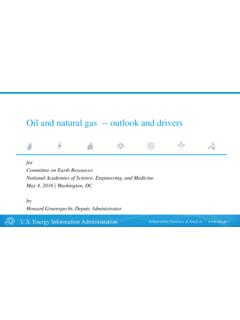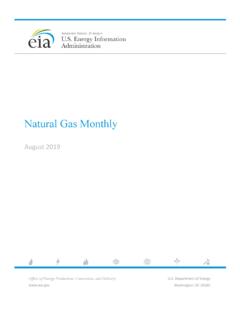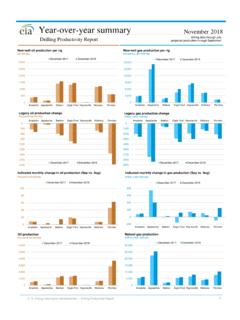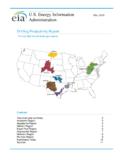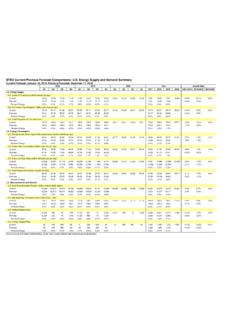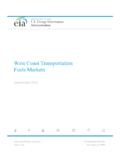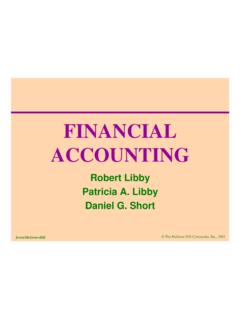Transcription of Levelized Costs of New Generation Resources in the Annual ...
1 Energy Information Administration | Levelized cost and Levelized Avoided cost of New Generation Resources AEO2020 1 February 2020 Levelized cost and Levelized Avoided cost of New Generation Resources in the Annual Energy Outlook 2020 Levelized cost of electricity (LCOE) and Levelized avoided cost of electricity (LACE) are, respectively, estimates of the revenue required to build and operate a generator over a specified cost recovery period and the revenue available to that generator over the same period.
2 This paper presents average values of LCOE and LACE for electric generating technologies entering service in 2022, 2025,1 and 2040 as represented in the National Energy Modeling System (NEMS) for the Energy Information Administration s (EIA) Annual Energy Outlook 2020 (AEO2020) Reference The Costs for electric generating facilities entering service in 2025 are presented in the body of this report, and those Costs for 20223 and 2040 are included in Appendices A and B, respectively. Both a capacity-weighted average based on projected capacity additions and a simple average (unweighted) of the regional values across the 25 supply regions of the NEMS electricity market module (EMM) are provided, together with the range of regional values.
3 Both LCOE and LACE are simplifications of modeled decisions, and do not not fully capture all the factors considered in NEMS. Nevertheless, when used together, these values provide an intuitive framework for understanding economic competitiveness between Generation technologies in the capacity expansion decisions than considering either one alone. Levelized cost of Electricity Levelized cost of electricity represents the average revenue per unit of electricity generated that would be required to recover the Costs of building and operating a generating plant during an assumed financial life and duty LCOE is often cited as a convenient summary measure of the overall competiveness of different generating technologies.
4 Key inputs to calculating LCOE include capital Costs , fuel Costs , fixed and variable operations and maintenance (O&M) Costs , financing Costs , and an assumed utilization rate for each plant The importance of each of these factors varies across technologies. For technologies with no fuel Costs and relatively small variable O&M Costs , such as solar and wind electric generating technologies, LCOE changes nearly in proportion to the estimated capital cost of the technology. For technologies with significant fuel cost , both fuel cost and capital cost estimates significantly affect LCOE.
5 Incentives, including state or federal tax credits (see text box AEO2020 representation of tax incentives for 1 Given the long lead-time and licensing requirements for some technologies, the first feasible year that all technologies are available is 2025. 2 The AEO2020 is available on EIA s website. 3 Appendix A shows LCOE and LACE for the subset of technologies available to be built in 2022. 4 Duty cycle refers to the typical utilization or dispatch of a plant to serve base, intermediate, or peak load.)
6 Wind, solar, or other intermittently available Resources are not dispatched and do not necessarily follow a duty cycle based on load conditions. 5 The specific assumptions for each of these factors are given in the Assumptions to the Annual Energy Outlook. Energy Information Administration | Levelized cost and Levelized Avoided cost of New Generation Resources AEO2020 2 renewable Generation ), also affect the calculation of LCOE. As with any projection, these factors are uncertain because their values can vary regionally and temporally as technologies evolve and as fuel prices change.
7 AEO2020 representation of tax incentives for renewable Generation Federal tax credits for certain renewable Generation facilities can substantially reduce the realized cost of these facilities. Based on the following and where applicable, the LCOE tables show the cost both with and without tax credits that EIA assumed would be available in the year in which the plant enters service. Production Tax Credit (PTC): New wind, geothermal, and closed-loop biomass plants receive $24 per megawatthour (MWh) of Generation ; other PTC-eligible technologies receive $12/MWh.
8 The PTC values are adjusted for inflation and applied during the plant s first 10 years of service. Plants that were under construction before the end of 2016 received the full PTC. After 2016, wind continues to be eligible for the PTC but at a $/MWh rate that declines by 20% in 2017, 40% in 2018, 60% in 20196, and expires completely in 2020. Based on documentation released by the Internal Revenue Service (IRS), EIA assumes that wind plants have four years after beginning construction to come online and claim the PTC.
9 As a result, wind plants entering service in 2021 will receive $ , and those plants entering service in 2023 will receive $ (inflation adjusted). Investment Tax Credit (ITC): In June 2018, the IRS issued Notice 2018-59, a beginning of construction guidance for the ITC. Based on the guideline, EIA assumes all solar projects coming online before January 1, 2024 will receive the full 30% ITC. Solar projects include both utility-scale solar plants those with capacity rating of 1 megawatt (MW) or greater and small-scale systems those systems with a capacity rating of less than 1 MW.
10 All commercial and utility-scale plants with a construction start date on or after January 1, 2022, or those plants placed in service after December 31, 2023, receive a 10% ITC. The ITC, however, expires completely for residential-owned systems starting in 2022. Results in this Levelized cost report only include utility-scale solar facilities and do not include small-scale solar facilities. Both onshore and offshore wind projects are eligible to claim the ITC in lieu of the PTC. Although EIA expects that onshore wind projects will choose the PTC, EIA assumes offshore wind projects will claim the ITC in lieu of the PTC because of the relatively higher capital Costs for those projects.

